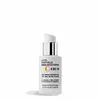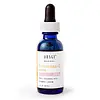What's inside
What's inside
 Key Ingredients
Key Ingredients

 Benefits
Benefits

 Concerns
Concerns

 Ingredients Side-by-side
Ingredients Side-by-side

Hyaluronic Acid
HumectantTripeptide-5
Skin ConditioningOleanolic Acid
Skin ConditioningSqualane
EmollientAscorbic Acid 15%
AntioxidantTetrahexyldecyl Ascorbate
AntioxidantTocopherol
AntioxidantNiacinamide 3%
SmoothingWater
Skin ConditioningPropylheptyl Caprylate
EmollientGlycerin
HumectantPentylene Glycol
Skin ConditioningDicaprylyl Ether
EmollientButylene Glycol
HumectantSucrose Polystearate
EmollientUndecane
EmollientCetearyl Alcohol
EmollientDisodium Cetearyl Sulfosuccinate
CleansingPhenoxyethanol
PreservativeTridecane
PerfumingHelianthus Annuus Seed Oil
EmollientCetyl Palmitate
EmollientAlcohol
AntimicrobialXanthan Gum
EmulsifyingCitric Acid
BufferingDisodium EDTA
Enantia Chlorantha Bark Extract
Skin ConditioningEthylhexylglycerin
Skin ConditioningGlyceryl Citrate/Lactate/Linoleate/Oleate
EmulsifyingPolyglyceryl-2 Oleate
EmulsifyingCaprylic/Capric Triglyceride
MaskingSodium Acetylated Hyaluronate
HumectantSodium Hyaluronate
HumectantSodium Hyaluronate Crosspolymer
HumectantAscorbyl Palmitate
AntioxidantHydrolyzed Sodium Hyaluronate
Skin ConditioningPalmitoyl Tripeptide-5
Skin ConditioningDimethylmethoxy Chromanol
AntioxidantHyaluronic Acid, Tripeptide-5, Oleanolic Acid, Squalane, Ascorbic Acid 15%, Tetrahexyldecyl Ascorbate, Tocopherol, Niacinamide 3%, Water, Propylheptyl Caprylate, Glycerin, Pentylene Glycol, Dicaprylyl Ether, Butylene Glycol, Sucrose Polystearate, Undecane, Cetearyl Alcohol, Disodium Cetearyl Sulfosuccinate, Phenoxyethanol, Tridecane, Helianthus Annuus Seed Oil, Cetyl Palmitate, Alcohol, Xanthan Gum, Citric Acid, Disodium EDTA, Enantia Chlorantha Bark Extract, Ethylhexylglycerin, Glyceryl Citrate/Lactate/Linoleate/Oleate, Polyglyceryl-2 Oleate, Caprylic/Capric Triglyceride, Sodium Acetylated Hyaluronate, Sodium Hyaluronate, Sodium Hyaluronate Crosspolymer, Ascorbyl Palmitate, Hydrolyzed Sodium Hyaluronate, Palmitoyl Tripeptide-5, Dimethylmethoxy Chromanol
Ingredients Explained
These ingredients are found in both products.
Ingredients higher up in an ingredient list are typically present in a larger amount.
Alcohol comes in many different forms. Different types of alcohol will have different effects on skin. This ingredient is usually an astringent alcohol.
These alcohols are drying on the skin. They may strip away your skin's natural oils and even damage your skin barrier. Astringent alcohols may also irritate skin.
Other types of astringent alcohols include:
According to the National Rosacea Society based in the US, you should be mindful of products with these alcohols in the top half of ingredients.
Any type of sanitizing product will have high amounts of alcohol to help kill bacteria and viruses.
Fatty alcohols come from plant oils such as coconut oil. These can help hydrate the skin and are non-irritating. Some fatty alcohols include cetyl and stearyl alcohol.
Learn more about AlcoholAscorbic Acid is is pure Vitamin C. This form makes up the largest amount of vitamin C found naturally in our skin.
Not only is vitamin C great for your overall health and immune system, it also has plenty of benefits on your skin.
Vitamin C is best used for brightening skin. It improves dark spots, acne scars, and hyperpigmentation. This is because it blocks the process of skin darkening when exposed to UV.
Remember: Vitamin C should not replace sunscreen!
Your skin uses vitamin C to build collagen. Collagen is one key component in having a strong skin barrier and plump skin. Vitamin C also plays a role in regulating collagen, thus making it effective in improving wrinkles and fine lines.
Ascorbic acid shows potent antioxidant activity. As an antioxidant, it helps fight free-radicals. Free-radicals are molecules that may damage your skin cells. These antioxidants also protect skin against UV damage.
The best formulations include Vitamin E and/or ferulic acid. These two ingredients help stabilize and provide a boost in the benefits of ascorbic acid. This is because ascorbic acid becomes unstable when exposed to UV and air. In fact, you can tell your ascorbic acid has oxidized when it turns an orange-yellow color.
Ascorbic acid is generally compatible with other ingredients. However, using ascorbic acid with other active ingredients might cause irritation. Two ingredients: copper ions and benzoyl peroxide, will inactivate ascorbic acid completely.
Read more about other types of Vitamin C:
Foods rich with vitamin C include oranges, strawberries, broccoli, bell peppers, and more. When consuming Vitamin C, your skin receives a portion of the nutrients.
Learn more about Ascorbic AcidPhenoxyethanol is a preservative that has germicide, antimicrobial, and aromatic properties. Studies show that phenoxyethanol can prevent microbial growth. By itself, it has a scent that is similar to that of a rose.
It's often used in formulations along with Caprylyl Glycol to preserve the shelf life of products.
Sodium Hyaluronate is hyaluronic acid's salt form. It is commonly derived from the sodium salt of hyaluronic acid.
Like hyaluronic acid, it is great at holding water and acts as a humectant. This makes it a great skin hydrating ingredient.
Sodium Hyaluronate is naturally occurring in our bodies and is mostly found in eye fluid and joints.
These are some other common types of Hyaluronic Acid:
Learn more about Sodium HyaluronateWater. It's the most common cosmetic ingredient of all. You'll usually see it at the top of ingredient lists, meaning that it makes up the largest part of the product.
So why is it so popular? Water most often acts as a solvent - this means that it helps dissolve other ingredients into the formulation.
You'll also recognize water as that liquid we all need to stay alive. If you see this, drink a glass of water. Stay hydrated!
Learn more about Water